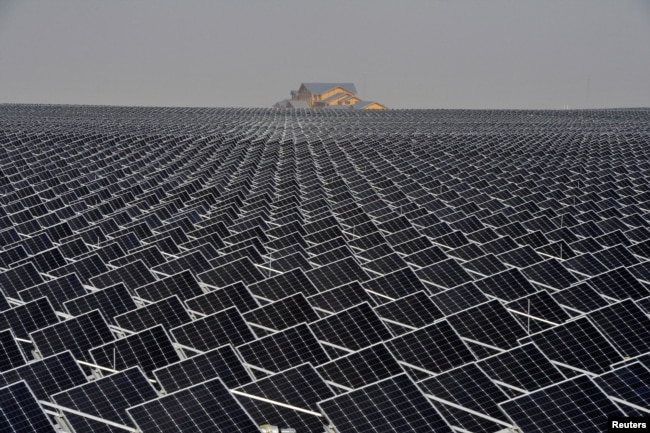" Britain's first solar panel uncovered after 60 years... and it still works.
By Adam Howlett
Apr 2010
The first ever solar panel has been uncovered after being hidden away forgotten in a box for 60 years - and incredibly, it STILL works.
The amazing contraption is the brainchild of a British science teacher who wanted to prove to his friends that it was possible to turn sunlight into electricity.
In 1950 he spent hours slaving in his laboratory to complete his cell based on the junction semiconductor idea patented in 1946 by Russell Ohl.
Michelle Gazeley-Howitt who works for the solar cell's owner Fred Nickson. The 60-year-old solar cell was the brainchild of a science teacher.
The slice of scientific history was picked up by antiques dealer Fred Nickson who bought the invention from distant relative of the man who built it.
The oddity, which looks like a crystal ball, had been put in a box and forgotten but is finally on show at yesterday's Antiques for Everyone show at Birmingham's NEC.
In direct sunlight the contraption can create 1.5 volts of electricity, which is enough power to run a modern day digital watch.
Mr Nickson said he was amazed a scientific object built so long ago still worked perfectly.
He said: 'The inventor built the contraption after people took the mickey out of him when he explained what he wanted to do.
'He became obsessed and spent hours slaving in his laboratory to realise his dream.
'It is similar to a solar panel you would get today, it uses a mineral called selenium to convert sunlight into electricity.
'But it has negative and positive versions of the mineral like Ohl's patented model.
'In direct sunlight it can produce the same amount of electricity as a watch battery - about 1.5 volts.
'The man who built it would not have thought he could run something off the panel - he just wanted to prove it could be done.
'It is funny to think that 60 years ago the person who built this would not have believed how the same thing is being used now.
'The solar panel is a real boys' toy - a slice of scientific history.'
The incredible find was taken into Chiltern Antiques in Henley-on-Thames, Oxfordshire, earlier this year.
A family member of the science teacher, who has not been identified but was from Surrey, sold the piece to the dealer.
The first basic solar technology was built in 1883 by Charles Fritts but was found to be far too inefficient and nothing like today's models.
Russian physicist Aleksandr Stoletov developed the concept further by developing the first solar cell based on the outer photoelectric effect, a more stable and reliable cell.
But it was not until Russell Ohm patented the idea of the junction semiconductor solar cell, that the modern day solar panel was born.
It is not known whether the American actually built a version of his modern solar cell, which means this artefact is thought to be the first one.
It works because some minerals, such as silicon and selenium, release electrons when hit by sunlight - producing an electric current.
In this form of solar device negative and positive minerals are combined to increase the efficiency of the cell.
But modern day solar panels do not need direct sunlight, they can create electricity just using ambient light.
This green piece of history is being shown at Antiques for Everyone, Britain's largest dedicated antiques event, with more than 50,000 treasures available to buy.
Spokesman Tom Grocott said the solar cell was a rare and special find.
He said: 'The fair always brings up these rare treats - it's very exciting. With such a huge selection of antiques on sale, you can find some exceptional treasures."
Source: Britain's first solar panel uncovered after 60 years... and it still works
By Adam Howlett
Apr 2010
The first ever solar panel has been uncovered after being hidden away forgotten in a box for 60 years - and incredibly, it STILL works.
The amazing contraption is the brainchild of a British science teacher who wanted to prove to his friends that it was possible to turn sunlight into electricity.
In 1950 he spent hours slaving in his laboratory to complete his cell based on the junction semiconductor idea patented in 1946 by Russell Ohl.
Michelle Gazeley-Howitt who works for the solar cell's owner Fred Nickson. The 60-year-old solar cell was the brainchild of a science teacher.

The slice of scientific history was picked up by antiques dealer Fred Nickson who bought the invention from distant relative of the man who built it.
The oddity, which looks like a crystal ball, had been put in a box and forgotten but is finally on show at yesterday's Antiques for Everyone show at Birmingham's NEC.
In direct sunlight the contraption can create 1.5 volts of electricity, which is enough power to run a modern day digital watch.
Mr Nickson said he was amazed a scientific object built so long ago still worked perfectly.
He said: 'The inventor built the contraption after people took the mickey out of him when he explained what he wanted to do.
'He became obsessed and spent hours slaving in his laboratory to realise his dream.
'It is similar to a solar panel you would get today, it uses a mineral called selenium to convert sunlight into electricity.
'But it has negative and positive versions of the mineral like Ohl's patented model.
'In direct sunlight it can produce the same amount of electricity as a watch battery - about 1.5 volts.
'The man who built it would not have thought he could run something off the panel - he just wanted to prove it could be done.
'It is funny to think that 60 years ago the person who built this would not have believed how the same thing is being used now.
'The solar panel is a real boys' toy - a slice of scientific history.'
The incredible find was taken into Chiltern Antiques in Henley-on-Thames, Oxfordshire, earlier this year.
A family member of the science teacher, who has not been identified but was from Surrey, sold the piece to the dealer.
The first basic solar technology was built in 1883 by Charles Fritts but was found to be far too inefficient and nothing like today's models.
Russian physicist Aleksandr Stoletov developed the concept further by developing the first solar cell based on the outer photoelectric effect, a more stable and reliable cell.
But it was not until Russell Ohm patented the idea of the junction semiconductor solar cell, that the modern day solar panel was born.
It is not known whether the American actually built a version of his modern solar cell, which means this artefact is thought to be the first one.
It works because some minerals, such as silicon and selenium, release electrons when hit by sunlight - producing an electric current.
In this form of solar device negative and positive minerals are combined to increase the efficiency of the cell.
But modern day solar panels do not need direct sunlight, they can create electricity just using ambient light.
This green piece of history is being shown at Antiques for Everyone, Britain's largest dedicated antiques event, with more than 50,000 treasures available to buy.
Spokesman Tom Grocott said the solar cell was a rare and special find.
He said: 'The fair always brings up these rare treats - it's very exciting. With such a huge selection of antiques on sale, you can find some exceptional treasures."
Source: Britain's first solar panel uncovered after 60 years... and it still works

